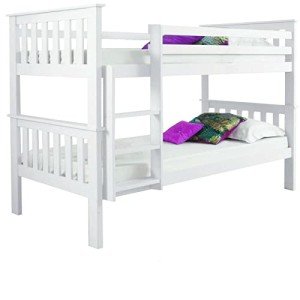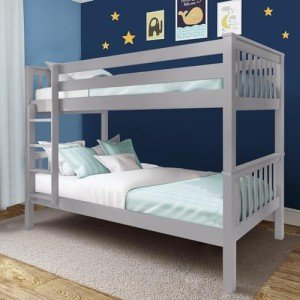Bunk beds have long been favored for their space-saving abilities and stylish designs. Among the various options available in today's markets, twin bunk beds with ladders and solid wood frames stand out for their durability, aesthetic appeal, and functionality. This guide will explore the unique features of twin bunk beds, their advantages, design options, maintenance tips, and more to help parents and caregivers make an informed decision.
What is a Twin Bunk Bed?
A twin bunk bed typically consists of two twin-sized beds stacked one on top of the other, connected by a ladder. It's a practical solution for shared rooms, maximizing floor space while providing comfort for both individuals. The solid wood frame is a critical element, significantly enhancing the bed's sturdiness and lifespan.
Features of Twin Bunk Beds
- Durability: Solid wood frames are renowned for their strength and longevity, often lasting for generations.
- Space-Saving Design: With a twin bunk bed, floor space can be used more efficiently, allowing room for other furniture or play areas.
- Safety Features: Many designs include guardrails and sturdy ladders to ensure the safety of the occupants.
- Style Variety: Available in various finishes and styles, twin bunk beds can complement any bedroom decor.
- Versatile Usability: Bunk beds are suitable for children and can be adapted for teenagers or guest rooms later on.
Benefits of Solid Wood Frames
Opting for a solid wood frame for bunk beds offers numerous advantages:
- Strength: Solid wood provides a robust structure capable of supporting heavier weights.
- Aesthetic Appeal: Wood exudes warmth and elegance, making it a timeless choice for home decor.
- Eco-Friendly: Many wooden bed frames are crafted from sustainable materials, appealing to environmentally conscious consumers.
- Customizability: Solid wood can be stained or painted to match any color scheme, offering versatility in design.
- Easy Maintenance: Wood surfaces are generally easy to clean and maintain when compared to some synthetic materials.
Common Types of Wood Used
| Type of Wood | Characteristics | Pros | Cons |
|---|---|---|---|
| Pine | Light color, soft texture | Affordable, lightweight | Less durable than hardwood |
| Oak | Strong, heavy, with pronounced grain | Highly durable, classic look | More expensive |
| Maple | Smooth finish, strong | Resistant to warping | Can be costly |
| Birch | Fine grain, light color | Durable and resistant to shock | Limited availability |
| Mahogany | Rich color, deeper grain | Luxurious appearance | Higher price point |
Choosing the Right Twin Bunk Bed
When selecting a twin bunk bed, there are several factors to consider:
Safety Considerations
- Guardrails: Ensure that the top bunk has sturdy guardrails to prevent falls.
- Ladder Design: Look for ladders that are securely attached and have wide steps for safety.
- Weight Capacity: Check the manufacturer's guidelines for weight limits to ensure that the bed supports the needed weight.
Space Requirements
- Measure the room to ensure the bunk bed fits comfortably, accounting for headspace and clearance.
- Consider any additional furniture (desks, dressers) to avoid overcrowding.
Style and Finish
- Consider the existing decor and choose a style that complements it.
- Look at finish options, such as natural wood, painted, or stained, for a look that suits personal taste.
Maintenance Tips for Solid Wood Bunk Beds
Keeping a bunk bed in optimal condition requires regular maintenance. Here are some useful tips:
- Regular Cleaning: Dust the surfaces with a soft cloth and clean spills promptly to avoid stains.
- Check for Loose Screws and Bolts: Regularly inspect the bed frame for any loose hardware and tighten where necessary.
- Avoid Excessive Moisture: Keep the bed dry to prevent warping or splitting of the wood.
- Protect the Finish: Use coasters or pads under items placed on the surface to protect against scratches.
Frequently Asked Questions (FAQs)
1. How much space do I need for a twin bunk bed?
You should ideally have at least 60 inches of vertical space above the top bunk to allow for safe use and comfort. Additionally, consider the floor space required for the ladder and any accessories.
2. What age is suitable for a child to sleep on the top bunk?
Most manufacturers recommend that children under the age of six should not sleep on the top bunk due to safety concerns. Always supervise younger children when using a bunk bed.
3. Can twin bunk beds be separated into two individual beds?
Yes, many twin bunk beds can be disassembled and used as individual twin beds if needed. This adds versatility to your bedroom arrangement.
4. Are bunk beds with solid wood frames worth the investment?
Absolutely. While solid wood bunk beds may be more expensive upfront than those made of pressed wood or metal, their durability and timeless appeal often justify the investment.
5. What is the best way to arrange a room with a twin bunk bed?
Consider placing the bunk bed against a wall for safety and space efficiency. Ensure that the ladder has adequate clearance and that the room layout allows for easy access to each bed.
Twin bunk beds with ladders and solid wood frames offer the perfect blend of style, functionality, and durability. They are an excellent choice for maximizing space in children’s rooms while providing a safe and comfortable sleeping environment. By considering the many features, benefits, and maintenance requirements discussed in this article, parents can confidently select a bunk bed that meets their family’s needs for years to come.






